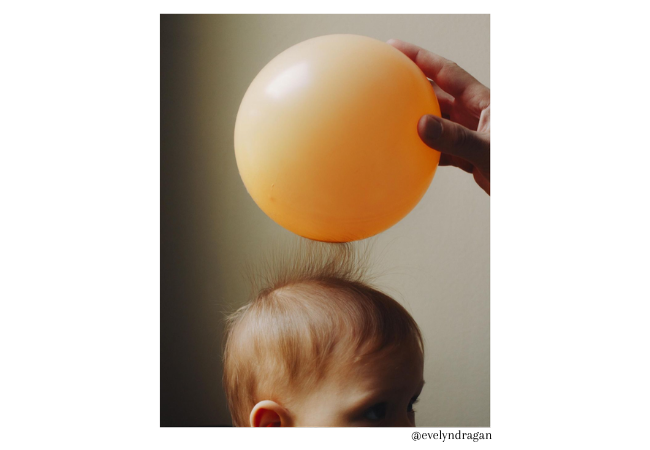Cradle cap: leave it alone !
01. 02. 2022

Baby's bath time ! A moment of tenderness and sharing. On his angel's scalp, small white or yellow patches have appeared: cradle cap. No need to worry, they are not painful for your baby nor are they a sign of any illness or allergy. Here is Enfance Paris' little guide to this benign and common infection during the first months of baby's life.
What is cradle cap?
Called "Infantile seborrhoeic dermatitis" in the medical vocabulary, these cradle caps take the appearance of patches of whitish or yellowish tint located on the scalp. They can also be found on the face near the eyebrows, eyelashes and fontanel, or in the infant's skin folds: arms, armpits, back of the ears, legs, seat. There are two types: a dry form, which appears very early in the life of babies who have inherited a skin with an oily tendency. And a wet form, accompanied this time by slight oozing.
This small dermal infection is linked to an excess of oily secretions (sebum) on the scalp. Dead skin cells accumulate and eventually coalesce to create that scaly look on your little one's pretty head. You could say that they are to babies what dandruff is to adults. And just like dandruff, there are simple steps you can take to treat it gently.
The onset and duration of the infection
The infection affects babies very early in life. It is generally between the 2nd and 4th week of life that the first patches appear. The peak of the infection is at the age of 3 months, which is when the cradle caps can be the most impressive on your little one's head. Particularly common, 70% of children under 3 months of age develop these unsightly little patches.
But the good news is that cradle cap is short-lived and disappears on its own in most babies as early as 6 months! In some cases, it may take until the age of 2 before they disappear completely, but there's nothing to worry about.
Occasionally, cradle cap reappears later in adolescence or even in adulthood, in a slightly different form.
When should I see a pediatrician?
As you can see, infant dermatitis is temporary and does not require any particular treatment. A little patience and the cradle cap will be a distant memory!
However, it is important to remain vigilant and monitor their appearance. Here are the cases in which to turn to your pediatrician for professional follow-up: Patches eventually appear all over the body. Cradle cap begins to smell. You notice pimples or inflammation on the scalp. Cradle cap does not disappear after age 3.
If you have any doubts about the appearance and evolution of cradle cap, you should seek professional advice.
The care routine to adopt for cradle cap :
Once again, cradle cap is not a sign of poor hygiene and is not a source of discomfort for baby! It is only a small aesthetic concern that can be gradually reduced by adopting a good daily care routine.
First of all, and we can't stress this enough, never ever scratch cradle cap with your fingernails or any other object! In addition to irritating your baby's scalp and pulling out his or her hair in the process, you risk causing superinfection with new bacteria. So remember this golden rule: don't touch the cradle cap!
Washing is the ideal time to look after cradle cap. It is the moment of pleasure with baby, while combining hygiene, efficiency and safety. An appropriate washing of the scalp followed by a delicate massage of the head are daily reflexes that will progressively limit cradle cap.
Once the washing is over and after a gentle drying with a clean towel, this moment of care and sharing can end with a careful brushing of baby's hair. A soft and supple brush adapted to small children is preferred. Don't bother with cradle caps: already softened by washing, the scales will fall off by themselves.
The frequency of washing is not important: what is important is the quality of the products. Washing too often can cause the scalp to dry out quickly. The use of overly aggressive care products will have the unfortunate tendency to accentuate the phenomenon, largely because of overly abrasive surfactants.

Enfance Paris' adapted care
Fragile and particularly sensitive to the aggressions of the world around it, the skin of infants is on average 5 times thinner than that of adults. It is therefore essential to use specific care products to take care of it and meet its needs to the maximum while protecting its purity.
For the delicate skin of the youngest, and in particular that of the skull, we have developed adapted care products that meet the strictest quality and safety standards. We make it a point of honor to distinguish the specificity of the skin according to age: the skin of infants and babies up to 3 years old does not have the same needs as that of young children of 8 years old, nor those of a pre-teenager of 12 years old.
For this common problem of cradle cap, Enfance Paris Gentle Shampoo 0-3 years liquid formula is a care of excellence perfectly adapted to the hair and scalp of babies from birth. Its soft and unique formula is enriched with effective and aromatic organic plant active ingrédients. Its extra-gentle protective washing base is made from coconut and sugar for an effective soap-free wash with delicate surfactants for this very sensitive area of baby's head.
What if baby doesn't have thick hair during his first year? Enfance Paris Protective Soothing Soap 0-3 years is just as suitable for the fluffy scalp of babies affected by seborrheic dermatitis!

For the small cradle caps which would have been lodged under the armpits, behind the knees or hidden in the cutaneous folds of your little one, our Extra Gentle Body wash is completely adequate too! Convenient particularly for the most sensitive skins, its washing base relipidante is composed of delicate tensioactives which do not attack the skin nor dry it. Gentle body & face wash is ideal to complete baby's cleansing and gently cleanse those delicate areas prone to seborrheic dermatitis.
The last word
Cradle cap is temporary and far from dangerous. We can only repeat: vigilance, patience and delicacy are the key words to act effectively against this phenomenon common to many babies. Once you've found a suitable care routine with high-quality, safe care products, the scabs will gradually disappear, leaving your little one's scalp untouched. This means even more cuddles with your little angels!
